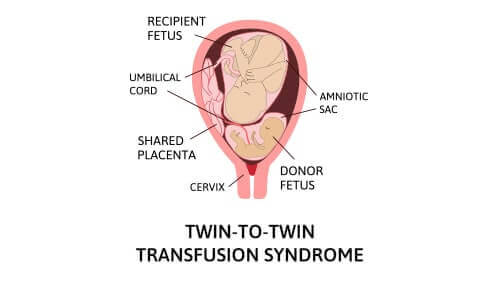
Call a twin-to-twin transfusion syndrome (TTTS) attorney today at (888) 424-5757 (toll-free phone call) or use the contact form to schedule a free case evaluation to discuss your family’s legal rights concerning your baby’s preventable birth trauma. Let us review your confidential or sensitive information and seek justice on your behalf.
About ten percent of identical twins (and other identical multiple babies) develop twin-to-twin transfusion syndrome (TTTS), a debilitating complication involving the placenta.
Typically, at least one monozygotic twin is affected when the fetus disproportionately shares a monochronic placenta. In many cases, restricted nutrients to one twin might result in abnormal growth or death.
Any failure to timely diagnose TTTS or treat the syndrome properly could be the basis of a medical malpractice case.
Twin-to-Twin Transfusion Syndrome (TTTS) Attorney for Medical Malpractice Case
Rosenfeld Injury Lawyers LLC represents victims of medical malpractice and other types of professional negligence. A medical malpractice lawyer can help you hold the negligent healthcare provider accountable for the harm that they caused.
Our law firm has successfully prosecuted cases for our clients whose children were injured by the negligent actions of others. In addition, our attorneys are available to answer any legal questions on how to receive the monetary compensation you deserve if your injuries resulted from someone else’s negligence.
Should you have additional questions, we invite you to give us a phone call or fill out a contact form for a free review of your legal rights.
What is Twin to Twin Transfusion Syndrome?
TTTS is a rare, severe disorder that involves a diseased placenta that affects both twins differently. Typically, one twin will become dehydrated and not produce adequate amounts of urine that would result in lower amniotic fluid levels and compromised fetal growth.
However, the body systems of the other twin will be overwhelmed with excessive levels of amniotic fluid and produce far more urine than average that causes an enlarged bladder. The overabundance of fluids can strain the twins’ hearts which might result in heart failure.
Many doctors referred to TTTS as twin oligohydramnios-polyhydramnios sequence (TOPS) and feto-fetal transfusion syndrome (FFTS) that all involve complications with disproportionate nutrients and blood supply. Children with the condition suffer serious side effects and increased mortality rates in Monochorionic multiples (multiple pregnancies).
In sporadic cases, the placenta vessel connections do not dispense an even flow of blood exchange to the twins. In this event, one twin continually loses a portion of their blood supply, risking organ failure and malnutrition.
The other twin typically has too much blood which could cause the heart to overwork and create fatal cardiac complications.
What Causes TTTS in Identical Twins?
Medical science has yet to determine the exact cause of Twin to Twin Transfusion Syndrome. However, doctors believe that abnormalities occur when the mother’s egg divides after fertilization, causing placental abnormalities leading to TTTS.
Typically, in identical multiple births, a monozygotic (identical) twin develops when the zygote (fertilized egg) divides in the first three days after conception, then it splits into two complete embryos.
At this time, each embryo receives nourishment from a separate (dichorionic) placenta in the early stages of pregnancy that will ultimately create two individuals with nearly identical DNA.
However, in some cases, the monozygotic twins take longer to divide from a single cell, which scientists believe can cause significant problems during pregnancy.
Some research shows that a zygote taking up to eight days to divide can create a shared (monochorionic) placenta with two amniotic sacs instead of two placentas, each with its amniotic sac.
If the fertilized egg does not separate until twelve days later, the twins can share a monochorionic placenta and only one amniotic sac. However, most scientists have yet to understand why a zygote can separate into twins or why it takes significantly longer than three days to occur in some cases.
Medical Terminology Related to Twin-To-Twin Cases
With twins, the baby receiving more blood flow is known as the ‘recipient’ while the baby receiving the diminished flow is considered the ‘donor.’ Both the recipient and donor babies are at risk of severe complications if doctors fail to identify and treat this condition.
The excess blood supply may cause the recipient baby to develop problems with their heart and lungs, while the reduced blood supply may contribute to developmental problems and even brain damage or cerebral palsy.
TTTS Complications Involving a Donor Twin and Recipient Twin
Twin-to-twin transfusion syndrome is a severe medical condition that dramatically affects identical twins’ health. Some of the common complications associated with Twin to Twin Transfusion Syndrome include:
- Donor twin anemia,
- Recipient twin heart failure is caused by the heart pumping excessive levels of blood,
- Recipient twin brain defects, heart problems, and digestive or respiratory health issues,
- Preterm labor caused by pregnancy induction or ruptured membranes,
- Donor twin compromised fetal development,
- Recipient twin health issues caused by the excessive amniotic fluid that leads to premature membrane rupture,
- Heart damage,
- Brain damage,
- Fetal death.
TTTS Signs and Symptoms
The common signs and symptoms of Twin to Twin Transfusion Syndrome occur halfway through pregnancy at 16 to 26 weeks.
Early indicators and warning signs that the fetuses are suffering from Twin to Twin Transfusion Syndrome will involve:
- Uterine contractions
- Abdominal tightness with associated pain
- Increased growth of the womb
- Leg and hand swelling that occurs in the beginning stage of pregnancy
- Unexpected, sudden weight gain
- An abnormally large uterus measurement
In some cases, the expectant mother will experience a significant increase in the size of her abdomen that involves discomfort and associated back pain. The pregnant woman may also detect decreased fetal movements or experience uterine contractions.
To identify TTTS, the medical professional may perform an ultrasound scan to measure amniotic fluid levels around the donor twin (to identify a decrease) and the recipient twin (to identify an increase) to confirm the diagnosis of Twin to Twin Transfusion Syndrome.
The ultrasound scan will also confirm evidence of:
- Same-sex twins,
- A single placenta,
- Shared or monochorionic placenta,
- Differently sized amniotic sacs,
- A marked difference in the identical twins’ fetus sizes,
- The presence of diminished amniotic fluid (oligohydramnios) surrounding the donor twin,
- The presence of excess amniotic fluid (polyhydramnios) surrounding the recipient twin,
- The recipient twin’s content of heart failure (CHF),
- A thin dividing membrane that is often difficult to see.
Twin-Twin Transfusion Syndrome Stages
Doctors classify TTTS in five distinct stages of development as an assistive guide for parents and treatment options. The stages that are identified using ultrasound include:
- Stage I– Early on, there is no amniotic fluid or reduced volumes surrounding the donor twin and increased fluid surrounding the recipient twin.
- Stage II– The donor twin can be viewed with an empty bladder, and possibly the bladder is not visible.
- Stage III– The umbilical cord provides abnormal blood flow levels to one or both twins. The stage also confirms fetal ductus venosus (where the flowing blood in a portion of the left umbilical vein is shunted to the inferior vena cava (IVC).
- Stage IV– The recipient twin experiences hydrops (an accumulation of fluid in the amniotic space). There might also be identifiable swelling in the skin surrounding the head and around the heart, the lungs, and the abdomen.
- Stage V– At least one twin is dead. A confirmed diagnosis of an increased progression of the syndrome often results in the donor twin’s poor prognosis of survival.
The performance of ultrasound can help measure each baby’s size and identify severe malformations. The test can also help the medical professional assess the placental location and where the cord is inserted. Usually, the doctor will require a vaginal ultrasound to assess the health and condition of the cervix.
Medical Interventions Available to Correct This Condition
Modern medicine now enables doctors to treat twin-to-twin transfusion syndrome using interventions intended to equalize the blood flow to the developing fetuses.
Today, specialists and surgeons can use amniocentesis or laser surgery to equalize the blood flow during critical developmental stages. In addition, when feasible, a treating physician may elect to induce labor to reduce the chance of further TTTS complications.
Twin to Twin Transfer Syndrome Long-Term Effects
Most pregnancies involving Twin-Twin Transfusion Syndrome never go to full-term. Because of that, many of these premature births share the same complications and long-term effects as other premature infants that include:
- Stunted physical development
- Learning disabilities
- Compromised communication skills
- Asthma and other respiratory problems
- Bronchopulmonary dysplasia (BPD), is a chronic lung disease caused by abnormal growth or inflammation
- Hearing loss
- Vision problems, including retinopathy
- Dental issues caused by delayed tooth growth may result in crooked teeth or tooth discoloration
- Increased risk of developing ADHD (Attention Deficit-Hyperactivity Disorder)
- The increased potential risk of SIDS (Sudden Infant Death Syndrome)
- Increased risk of developing chronic diseases, including diabetes, hypertension, or heart disease
My Twin Suffered TTTS. Should I Be Concerned About Future Pregnancies?
Approximately one out of 1000 pregnancies involves Twin-Twin Transfusion Syndrome. So likely, your future risk of birthing identical twins suffering from TTTS is about the same as they were during your first pregnancy.
Was My Doctor at Fault for Causing TTTS?
The evidence and facts surrounding your case are unique, which can make it difficult to determine if the doctor was at fault for causing your children to experience Twin-Twin Transfusion Syndrome.
However, the medical professional may be financially liable if their actions were negligent and they did not accurately diagnose your children’s condition while in the womb. For example, the doctor might not have performed the proper tests or followed up on early indicators that something was wrong, including:
- There was an identifiable difference between each fetus’ umbilical cord size
- There were apparent differences in amniotic fluid and amniotic sac size
- The size of each baby was significantly different
The doctor must follow specific measurements identified during an ultrasound test that can detect the apparent signs of TTTS.
Sample TTTS Negotiated Settlements and Jury Verdicts
Delaware County, Pennsylvania
The plaintiff and defendant agreed to a negotiated $2.3 million settlement. The case involved a five-year-old female who suffered severe neurological injuries caused by the alleged failure of the doctor to diagnose TTTS and provide effective treatment. At ten weeks of gestation, the expectant mother underwent an ultrasound revealing that the pregnancy involved identical twins.
Lawsuit documents show that the radiologist misinterpreted the ultrasound results, and in his failure to do his duty, he did not determine whether the twins were sharing the placenta which would have increased pregnancy complications.
Eight weeks later, doctors performed a follow-up ultrasound that identified a discrepancy in the twins’ weight. There was also a noticeable amniotic fluid imbalance and different abdominal circumferences, which are apparent symptoms of TTTS.
Court documents show that doctors performed a third ultrasound when the expectant mother was 29 weeks pregnant. That test revealed that the smaller twin had died, which caused unsustainable levels of the surviving twin’s blood to the dead twin, causing the survivor to suffer hypoxia (oxygen deficiency) that led to a neurological injury.
The five-year-old plaintiff’s $2.3 million settlement funds will be held in a trust to ensure her future needs are met.
TTTS Medical Malpractice Birth Injuries
When you suspect that an OB/GYN’s negligence in diagnosing or treating your babies’ twin-to-twin transfusion syndrome resulted in injury or death to one or both twins, begin the process of exploring your legal options with a nationally recognized birth injury law firm.
Rosenfeld Injury Lawyers LLC has worked with other parents facing similar issues and has the resources to bring closure to an incredibly challenging period in your life.
We have successfully obtained millions on behalf of the victims and their family members to ensure they were adequately compensated to cover their medical expenses, household bills, lost wages, loss of future earnings, pain, suffering, and emotional damage, and we can help your family too.
Birth Injury Attorneys for Twin-to-Twin Transfusion Cases
Our legal team encourages you to contact our attorneys today to schedule a free, no-obligation case consultation to discuss the merits of your monetary recovery claim.
We accept all personal injury cases, wrongful death lawsuits, and medical mistake injury claims through contingency fee arrangements. This legal contract postpones the payment of legal services until after we have successfully completed your case through a negotiated settlement or a jury verdict.
Our law firm gets results for our clients with medical malpractice claims. We proudly offer every client a “No Win/No-Fee” Guarantee, meaning if we cannot secure financial compensation on your behalf, you owe us nothing.
All confidential or sensitive information you share remains private through an attorney-client relationship. In addition, our entire team of birth injury attorneys currently follow CDC (Centers for Disease Control and Prevention) Covid-19 (coronavirus pandemic) social distancing guidelines to ensure our client’s safety.
Resources:
- National Institute of Health – Rare Diseases – Twin-Twin Transfusion Syndrome
- UCSF – Twin-to-Twin Transfusion Syndrome
Many medical malpractice cases have already been resolved through million-dollar settlements to ensure families have sufficient financial compensation for providing all the treatment and care their child requires.







